#sustainable agriculture
Text
"Marginal improvements to agricultural soils around the world would store enough carbon to keep the world within 1.5C of global heating, new research suggests.
Farming techniques that improve long-term fertility and yields can also help to store more carbon in soils but are often ignored in favor of intensive techniques using large amounts of artificial fertilizer, much of it wasted, that can increase greenhouse gas emissions.
Using better farming techniques to store 1 percent more carbon in about half of the world’s agricultural soils would be enough to absorb about 31 gigatons of carbon dioxide a year, according to new data. That amount is not far off the 32 gigaton gap between current planned emissions reduction globally per year and the amount of carbon that must be cut by 2030 to stay within 1.5C.
The estimates were carried out by Jacqueline McGlade, the former chief scientist at the UN environment program and former executive director of the European Environment Agency. She found that storing more carbon in the top 30 centimeters of agricultural soils would be feasible in many regions where soils are currently degraded.
McGlade now leads a commercial organization that sells soil data to farmers. Downforce Technologies uses publicly available global data, satellite images, and lidar to assess in detail how much carbon is stored in soils, which can now be done down to the level of individual fields.
“Outside the farming sector, people do not understand how important soils are to the climate,” said McGlade. “Changing farming could make soils carbon negative, making them absorb carbon, and reducing the cost of farming.”
She said farmers could face a short-term cost while they changed their methods, away from the overuse of artificial fertilizer, but after a transition period of two to three years their yields would improve and their soils would be much healthier...
Arable farmers could sequester more carbon within their soils by changing their crop rotation, planting cover crops such as clover, or using direct drilling, which allows crops to be planted without the need for ploughing. Livestock farmers could improve their soils by growing more native grasses.
Hedgerows also help to sequester carbon in the soil, because they have large underground networks of mycorrhizal fungi and microbes that can extend meters into the field. Farmers have spent decades removing hedgerows to make intensive farming easier, but restoring them, and maintaining existing hedgerows, would improve biodiversity, reduce the erosion of topsoil, and help to stop harmful agricultural runoff, which is a key polluter of rivers."
-via The Grist, July 8, 2023
#agriculture#sustainable agriculture#sustainability#carbon emissions#carbon sequestration#livestock#farming#regenerative farming#native plants#ecosystems#global warming#climate change#good news#hope
4K notes
·
View notes
Text
Every once in a while I’ll see some posts about everyone should become vegan in order to help the environment. And that… sounds kinda rude. I’m sure they don’t mean to come off that way but like, humans are omnivores. Yes there are people who won’t have any animal products be it meat or otherwise either due to personal beliefs or because their body physically cannot handle it, and that’s okay! You don’t have to change your diet to include those products if you don’t want to or you physically can’t.
But there’s indigenous communities that hunt and farm animals sustainably and have been doing so for generations. And these animals are a primary source of food for them. Look to the bison of North America. The settlers nearly caused an extinction as a part of a genocide. Because once the Bison were gone it caused an even sharper decline of the indigenous population. Now thankfully Bison did not go extinct and are actively being shared with other groups across America.
Now if we look outside of indigenous communities we have people who are doing sustainable farming as well as hunting. We have hunting seasons for a reason, mostly because we killed a lot of the predators. As any hunter and they will tell you how bad the deer population can get. (Also America has this whole thing about bird feathers and bird hunting, like it was bad until they laid down some laws. People went absolutely nuts on having feathers be a part of fashion like holy cow.)
We’re slowly getting better with having gardens and vertical farms within cities, and there’s some laws on being able to have a chicken or two at your house or what-have-you in the city for some eggs. (Or maybe some quails since they’re smaller than chickens it’s something that you’d might have to check in your area.) Maybe you would be able to raise some honey bees or rent them out because each honey tastes different from different plants. But ultimately when it comes to meat or cheese? Go to your local farmers. Go to farmers markets, meet with the people there, become friends, go actively check out their farm. See how the animal lives are and if the farmer is willing, talk to them about sustainable agriculture. See what they can change if they’re willing. Support indigenous communities and buy their food and products, especially if you’re close enough that the food won’t spoil on its way to you. (Like imagine living in Texas and you want whale meat from Alaska and you buy it from an indigenous community. I would imagine that would be pretty hard to get.)
Either way everything dies in the end. Do we shame scavengers for eating corpses they found before it could rot and spread disease? Do we shame the animals that hunt other animals to survive? Yes factory farming should no longer exist. So let’s give the animals the best life we can give them. If there’s babies born that the farmer doesn’t want, give them away to someone who wants them as a pet. Or someone who wants to raise them for something else. Not everyone can raise animals for their meat. I know I can’t I would get to emotionally attached. I’d only be able to raise them for their eggs and milk.
Yeah this was pretty much thrown together, and I just wanted to say my thoughts and throw them into the void. If you have some examples of sustainable farming/agriculture, please share them because while I got some stuff I posted from YouTube, I’m still interested to see what stuff I might’ve missed!
#solarpunk#farming#hunting#agriculture#sustainability#sustainable farming#sustainable agriculture#like Rewilding farm land is pretty interesting and trying to replicate an ecosystem with farm animals but also allowing wild animals#to make homes in the rewild farm land is pretty cool#and I have an absolute love for food/garden forests#and hydroponics have shown to be really great for communities in the winter time and they want to have fresh produce#all sorts of cool stuff
842 notes
·
View notes
Text
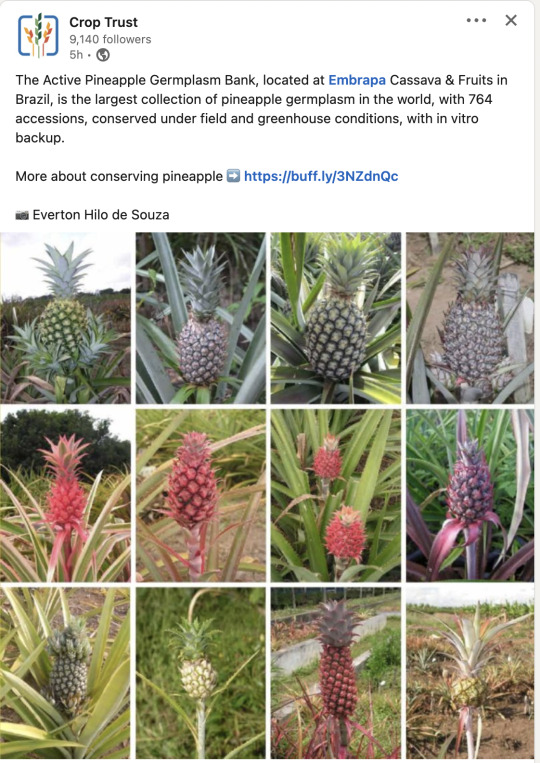
The surprising diversity of Pineapples (Ananas comosus).
The Active Pineapple Germplasm Bank (Pineapple AGB) of Embrapa Cassava & Fruits (Embrapa/ CNPMF) has more than 700 accessions under field conditions. As backups, there are copies kept in a greenhouse, with one or two plants per accession, cultivated in plastic pots with commercial substrate. An in vitro gene bank was established in 2003, and during the past few years, several studies have been carried out to improve the in vitro conservation protocol. Currently, about 60% of the AGB’s accessions are preserved by this protocol. Another conservation strategy used is cryopreservation of shoot tips and pollen grains, with well-defined methods. One of the most significant advances in the pineapple germplasm conservation has been the implementation of a quality control system, which enabled to define standard operation procedures (SOP) towards a more efficient and safer germplasm conservation.
Source:
Vidigal Souza, Fernanda & Souza, Everton & Aud, Fabiana & Costa, Eva & Silva, Paulo & Andrade, Eduardo & Rebouças, Danilo & Andrade, Danilo & Sousa, Andressa & Pugas, Carlos & Rebouças, Érica & França, Beatriz & França, Rivã. (2022). Advances in the conservation of pineapple genetic resources at Embrapa Cassava and Fruits. 28. 28-33.
#katia plant scientist#botany#plant biology#plant science#plants#fruit#pineapple#pineapples#biodiversity#agriculture#conservation#genetic diversity#sustainable agriculture#tropical plants#science#biology
254 notes
·
View notes
Text

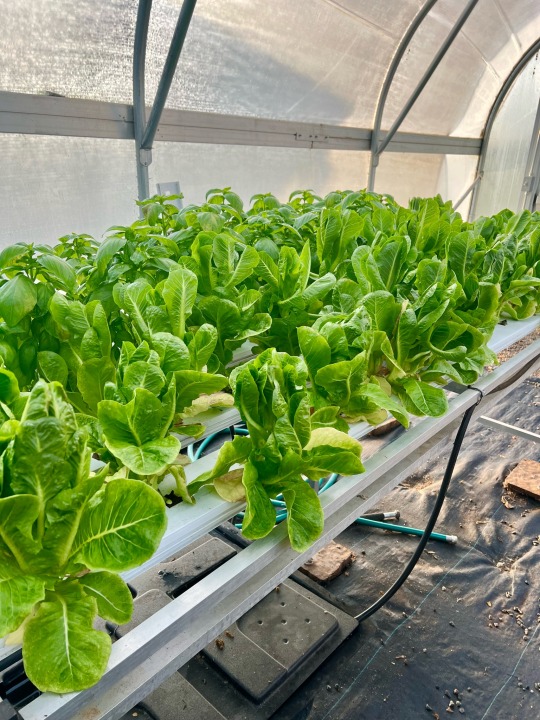
9/19/23 ~ Hydroponics at school. Those cucumbers grew super fast 😳 and some Romaine Lettuce!
#indoor garden#container gardening#sustainable gardening#vegetable gardening#starting seeds#grow organic#grow your own food#organic gardening#tomato garden#green witch#greenhouse#greenhouse nursery#plant nursery#hydroponics#growing cucumbers#romaine lettuce#sustainable agriculture
56 notes
·
View notes
Note
So happy to have found this blog!
But any chance do you listen to the podcast "How to Save a Planet" by Gimlet? It's focused on climate change solutions, and seems like something you and your followers might be into.
One of my favorite episodes of theirs is Sheep + Solar, a Love Story: which talks dual purpose solar farms, which can be used to graze animals/grow crops at the same time they provide solar power. :)
I do not currently listen to that podcast, but I just downloaded a few episodes to try out--thanks for the recommendation! Here's a link to the podcast for anyone else who is interested.
The sheep + solar combination is such an ingenious win-win situation. For those not familiar: if you have a solar farm, you don't want plants to grow high enough to shade your solar panels and a great way to prevent this (and make your farm even more productive) is to keep grazing animals around. Cows are too large to graze under most solar panels (as well as being large and destructive) and goats will climb on the solar panels and chew the wires, but sheep are perfect. The space under the panels is also great for growing certain crops that prefer shade.
Sustainable agriculture + sustainable energy.
#ask#submission#sustainable agriculture#sustainable energy#green energy#renewable energy#solar panels#solar energy#solar farms#sheep#good news#climate change#climate change adaptation
226 notes
·
View notes
Text
Intro to U.S. Agriculture Book Recommendations
Requested by @languagesandpain
Healing Grounds by Liz Carlisle
If you're interested in agroecology this is a great place to start. It highlights a handful of Black, Latino, and Asian American farmers and their lives, history, and research. It's a great all-around book too because it touches on animal agriculture, produce, and mushrooms (which I don't see get talked about much), and also different methods like agroforestry and pasture systems.
Grain by Grain by Bob Quinn and Liz Carlisle
This book is basically the story of Bob Quinn and his farm, there's a lot of good info in it. This is the first book that really struck home to me that I need to listen to people in conventional agriculture even if I personally don't like it, because there's important experiences that need to be heard. It touches on topics like converting farms to more sustainable methods, heirloom crops, and how we deal with food/diet related science in the US. I don't have any health issues of note, but after reading this book I found an organic bread with Kamut wheat in it to see how it was, and it totally takes away any white on my tongue when I'm eating it daily. Pretty fascinating.
Perilous Bounty by Tom Philpott
This book widely covers major problems in US conventional agriculture, mostly covering major agriculture corporations and environmental impacts but also some labor issues, and small/mid size farm struggles. I'm not going to lie, this one is depressing. I generally do well with tough topics but near the end I had to put it down a few times because it was making me feel a bit hopeless. Which I fault the author with a bit for not dealing with better, because we need more hope to be able to believe these problems are fixable. He also doesn't cover the eastern US which irks me a bit because the south is a major agricultural region. But overall, a lot of great info and some interesting ideas for solutions near the end.
With These Hands by Daniel Rothenberg
I haven't actually read this one yet, but I've read sections. It looks like another tough read, but covers the experiences of migrant farmworkers across the US. Definitely trigger warnings for modern day slavery, racism, abuse, and more.
Dirt: The Erosion of Civilizations
I found this one to be a bit pessimistic honestly, but I read it a while ago so I dont remember what exactly bothered me. But it's a good overview of agricultural collapse through history, soil science, and issues in soil today.
Lentil Underground by Liz Carlisle
(Can you tell I've read all of Carlisle's books yet). So this book didn't really make much of an impression on me. But I'm recommending it because if anything it kind of illustrates the tediousness of policy change, changing people's minds, running an unconventional farm. It's a bit boring compared to the other recommendations but if you're in the industry there's things to think about in it.
Non-book recommendations
For a while was listening to Real Organic Podcast. After about 10 episodes (not in order) you notice they start to really repeat a lot of ideas. But they have a lot of episodes that highlight problems with chemical use, water use, how movements like organic get co-opted by big corporations, and more.
I also recommend the news website Civil Eats. They post a lot of book recommendations, as well as cover a whole variety of agricultural issues across the world.
If anyone has any additional recommendations feel free to add on! I'm always looking for more books >:)
#not langblr#agriculture#agroecology#sustainable agriculture#regenerative agriculture#environmentalism#environmental justice#book recommendations
40 notes
·
View notes
Text

Solarpunk orchard
#solarpunk#orchard#farmland#farmhouse#green roof#art#ai#sustainable architecture#architecture#midjourney#midjourney art#digital art#farm life#homesteading#house#home#rural#sustainable agriculture#agriculture
227 notes
·
View notes
Text
I'm curious as to how well known these services are outside of ag communities.
The food distribution thing may or may not be less well-known because it is typically done through a government service or non-profit, but not always! And it is a service lots of small farm owners are doing.
#had to remake cause i always accidentally let the poll only be for a day. augh.#agroecology#sustainable agriculture#food justice
9 notes
·
View notes
Text
So on dendryte's suggestion, I read a paper called "Feed your friends: do plant exudates shape the root microbiome?", and it is awesome and filled with ideas that were new to me, and all in all was very exciting. Like, I didn't even know about/remember border cells, and they apparently do a whole lot! I'm back from work now, so now I'm going to share the Questions I have, and am going to spend the weekend looking for sources on:
1. As crop rotation was developed for a tilled, monoculture system as a way to address the disease issues that pop up in such a system, is crop rotation actually beneficial in a no-till, truly polyculture setting where care is taken to support mycorrhizae?
As we know know that plants alter the population of bacteria in the soil, and that these population compositions differ between plant species, is it possible that there might be some benefits to planting the same crop in the same location if you're not disrupting microbe populations through tilling?
2. Since we know that applications of nitrogen can cause plants to kick out their symbiotic fungal partners, increasing their vulnerability to pathogenic fungi & drought, might it be better to place fertilizer outside of the root zone so as to force the plant to use the mycelium to get at it?
How far can mycorrhizal networks transport mineral nutrients? Are they capable of transporting all the mineral nutrients plants need? In other words, can I make a compost pile in the middle of the garden and be lazy and depend on the fungal network to distribute the goods?
3. How deep can fungal hyphe go? In other words, in areas with shallow wells, and thus fairly shallow water tables, can we encourage mycorrhizae enough to be able to depend on them for irrigation?
4. For folks on city water, does the chlorine effect plants' microbiome both above and below ground?
5. When do plants start producing exudates? If you had soil from around actively growing plants of the same species you're sowing, could the bacteria and fungi play a role in early seedling vigor & health?
6. Has anyone directly compared the micronutrient profiles of the same crop grown in organic but tilled settings against those grown in no-till, mycorrhizae-friendly settings?
7. Since we know that larger molecules, such as sugar, can be transported across fungal networks between different species (Suzanne Simard is where I first food this info) , have we checked for other compounds created by plants? Say, compounds used by plants to protect against insect herbivory?
8. Since we know blueberries use ericoid mycorrhizae rather than endo- or ectomycorrhizae (which are the two types used by most plants), but gaultheria (salal & winter green) use both ericoid & ectomycorrhizae, and alder uses both endo & ectomycorrhizae (and fix nitrogen too!), and clover use endomycorrhizae, might blueberries be more productive if there's a nearby hedge of salal/wintergreen, alder, and clover? Willows and aspens also both use endo & ecto, so they could be included, and the trees could also be coppiced for firewood or basketry supplies.
I'm going to spend some time this weekend reading research papers. If anyone happens to know any that address these (or related questions), please send them my way!
85 notes
·
View notes
Text



It’s been lovely lately
#goats#cheese#sustainable agriculture#sustainability#Vermont#farm animals#cute goats#farming#farm core#cottagecore#cottage aesthetic#farm
6 notes
·
View notes
Text
"In response to last year’s record-breaking heat due to El Niño and impacts from climate change, Indigenous Zenù farmers in Colombia are trying to revive the cultivation of traditional climate-resilient seeds and agroecology systems.
One traditional farming system combines farming with fishing: locals fish during the rainy season when water levels are high, and farm during the dry season on the fertile soils left by the receding water.
Locals and ecologists say conflicts over land with surrounding plantation owners, cattle ranchers and mines are also worsening the impacts of the climate crisis.
To protect their land, the Zenù reserve, which is today surrounded by monoculture plantations, was in 2005 declared the first Colombian territory free from GMOs.
...
In the Zenù reserve, issues with the weather, climate or soil are spread by word of mouth between farmers, or on La Positiva 103.0, a community agroecology radio station. And what’s been on every farmer’s mind is last year’s record-breaking heat and droughts. Both of these were charged by the twin impacts of climate change and a newly developing El Niño, a naturally occurring warmer period that last occurred here in 2016, say climate scientists.
Experts from Colombia’s Institute of Hydrology, Meteorology and Environmental Studies say the impacts of El Niño will be felt in Colombia until April 2024, adding to farmers’ concerns. Other scientists forecast June to August may be even hotter than 2023, and the next five years could be the hottest on record. On Jan. 24, President Gustavo Petro said he will declare wildfires a natural disaster, following an increase in forest fires that scientists attribute to the effects of El Niño.
In the face of these changes, Zenù farmers are trying to revive traditional agricultural practices like ancestral seed conservation and a unique agroecology system.
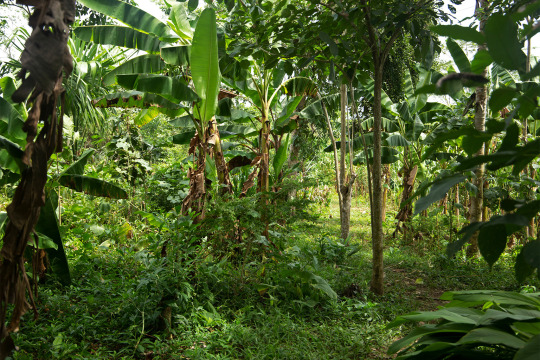
Pictured: Remberto Gil’s house is surrounded by an agroforestry system where turkeys and other animals graze under fruit trees such as maracuyá (Passiflora edulis), papaya (Carica papaya) and banana (Musa acuminata colla). Medicinal herbs like toronjil (Melissa officinalis) and tres bolas (Leonotis nepetifolia), and bushes like ají (Capsicum baccatum), yam and frijol diablito (beans) are part of the undergrowth. Image by Monica Pelliccia for Mongabay.
“Climate change is scary due to the possibility of food scarcity,” says Rodrigo Hernandez, a local authority with the Santa Isabel community. “Our ancestral seeds offer a solution as more resistant to climate change.”
Based on their experience, farmers say their ancestral seed varieties are more resistant to high temperatures compared to the imported varieties and cultivars they currently use. These ancestral varieties have adapted to the region’s ecosystem and require less water, they tell Mongabay. According to a report by local organization Grupo Semillas and development foundation SWISSAID, indigenous corn varieties like blaquito are more resistant to the heat, cariaco tolerates drought easily, and negrito is very resistant to high temperatures.
The Zenù diet still incorporates the traditional diversity of seeds, plant varieties and animals they consume, though they too are threatened by climate change: from fish recipes made from bocachico (Prochilodus magdalenae), and reptiles like the babilla or spectacled caiman (Caiman crocodilus), to different corn varieties to prepare arepas (cornmeal cakes), liquor, cheeses and soups.
“The most important challenge we have now is to save ancient species and involve new generations in ancestral practice,” says Sonia Rocha Marquez, a professor of social sciences at Sinù University in the city of Montería.
...[Despite] land scarcity, Negrete says communities are developing important projects to protect their traditional food systems. Farmers and seed custodians, like Gil, are working with the Association of Organic Agriculture and Livestock Producers (ASPROAL) and their Communitarian Seed House (Casa Comunitaria de Semillas Criollas y Nativas)...
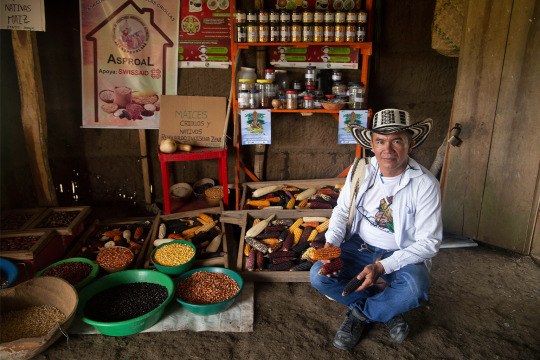
Pictured: Remberto Gil is a seed guardian and farmer who works at the Communitarian Seed House, where the ASPROL association stores 32 seeds of rare or almost extinct species. Image by Monica Pelliccia for Mongabay.
Located near Gil’s house, the seed bank hosts a rainbow of 12 corn varieties, from glistening black to blue to light pink to purple and even white. There are also jars of seeds for local varieties of beans, eggplants, pumpkins and aromatic herbs, some stored in refrigerators. All are ancient varieties shared between local families.
Outside the seed bank is a terrace where chickens and turkeys graze under an agroforestry system for farmers to emulate: local varieties of passion fruit, papaya and banana trees grow above bushes of ají peppers and beans. Traditional medicinal herbs like toronjil or lemon balm (Melissa officinalis) form part of the undergrowth.
Today, 25 families are involved in sharing, storing and commercializing the seeds of 32 rare or almost-extinct varieties.
“When I was a kid, my father brought me to the farm to participate in recovering the land,” says Nilvadys Arrieta, 56, a farmer member of ASPROAL. “Now, I still act with the same collective thinking that moves what we are doing.”
“Working together helps us to save, share more seeds, and sell at fair price [while] avoiding intermediaries and increasing families’ incomes,” Gil says. “Last year, we sold 8 million seeds to organic restaurants in Bogotà and Medellín.”
So far, the 80% of the farmers families living in the Zenù reserve participate in both the agroecology and seed revival projects, he adds."
-via Mongabay, February 6, 2024
#indigenous#ecology#agroforestry#agriculture#traditional food systems#traditional medicine#sustainable agriculture#zenu#indigenous peoples#farming#colombia#indigenous land#traditional knowledge#seeds#corn#sustainability#botany#plant biology#good news#hope#climate action#climate change#climate resilience#agroecology#food sovereignty
1K notes
·
View notes
Note
I'm wondering if at some point you'll be up for sharing your full detailed plans for your biomes once they're each done? No worries if you don't want to, it's too much effort or whatever. I just think it'd be super cool to see! (Extra bonus points if there's a bit of a map. Maps are cool!)
So this feels like a fun way to announce a little project I'm working on, and that some lovely folks voted to influence the debut of:
I'm working on a zine!
It's going to involve sharing the plant guilds I'm creating, along with the relevant background information on each plant within the guild, instructions on one type of functional use of the plant, knowledge about how and why one plans and executes a plant guild, etc!
Basically, I figured it'd be a fun and helpful way for me to absorb the information I need about my Food Forest, plan and design it, and execute those plans, and also make that knowledge pleasantly available to others. I figure as the Food Forest develops, I can create additional Zines or adapt the existing Zine to continue to document and share the progress with folks who are interested in learning more about how, why, what, where, when, and all the rest.
It should be a really interesting process, because I expect for a lot of the work to be theoretical for a while, then work-away-from-home for another while, and then finally we'll fully integrate human living into the food forest. That ought to bring layers to how we approach it.
Either way, if you would like to receive announcements about the Zine as I begin organizing and sending out my research, laying out and illustrating the first issue of the Zine, and (yay!) release the debut issue, please fill out the following survey with your preferred contact information:
I've probably fucked myself for getting views via the tags by putting links in here, so lend a hand and reblog ifn you think this is something you or someone you know might be interested in I guess 😆
Me and the wife have been dreaming about this for a long time, you know? Come live our queer dreams with us, they are many and soft, and it's kind of nice to learn how to prepare marigolds and dandelions and corn meal and goat cheese into a vegetable and cheese empanada.
22 notes
·
View notes
Text

22 ways to Go Organic on a Budget article
One of my constant goals is to increase how much of our food is organic. I'm no where near perfect at this (pregnancy cravings just had me ordering gluten free mint Oreos and Arizona green tea from Walmart lol), but in the spring and summer when most produce is in season I try to buy as much of our produce organic as we can afford. When I'm home with my parents the majority of my produce comes from their massive garden, all of our eggs come from their chickens, and all of our pork from their pigs. None of this is certified organic obviously, and they don't use organic animal feed, but I honestly still prefer these things. I love knowing exactly where my food comes from and how my meat was raised before harvest.
#organic#holistic#holistichealth#holisticwellness#crunchy mom#hippie mom#holistic health#holistic home#natural living#natural home#simple life#simple living#slow living#sustainable#sustainability#sustainable living#sustainable agriculture#ecofriendly#gogreen#sustainable home#homesteading#gardening#homemaker#homemaking#housewife#stay at home mom#traditional femininity#traditional gender roles#tradwife#tradfem
6 notes
·
View notes
Text

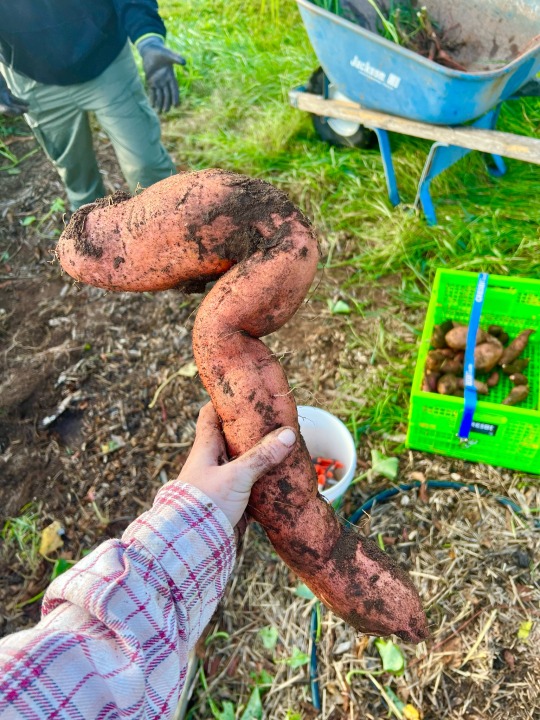
9/19/23 ~ Sweet Potato harvest at school today. Some of these suckers were HUGE! I took home a lot.
Recipes to come 😇
#indoor garden#container gardening#sustainable gardening#vegetable gardening#starting seeds#grow organic#grow your own food#organic gardening#tomato garden#green witch#sweet potato#potato garden#harvest season#harvesting#vegetarian#veganuary#sustainable agriculture
30 notes
·
View notes
Text
Brazil wants farmers to help save the Amazon. Will it work? | Context
#brazil#amazon rainforest#deforestation#pasture degradation#conservation#sustainable agriculture#luiz inacio lula da silva#climate change
3 notes
·
View notes
Text
Lucrative investment opportunities in sustainable agriculture. Discover how eco-friendly farming practices offer financial growth while contributing to a sustainable future.
2 notes
·
View notes